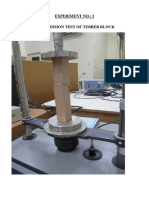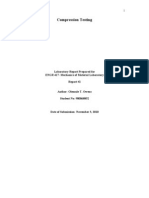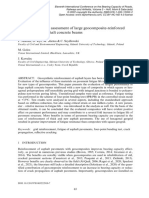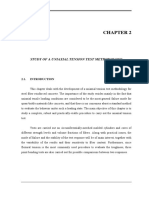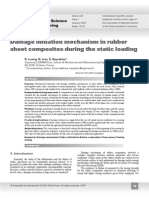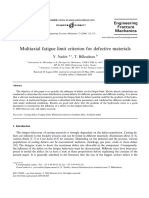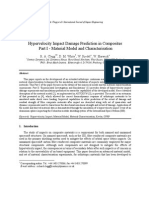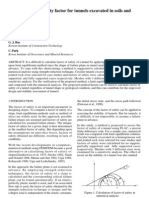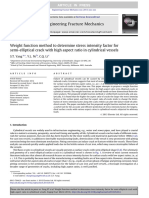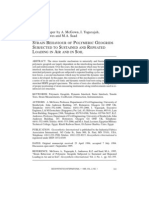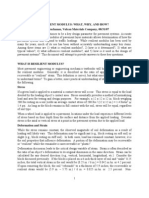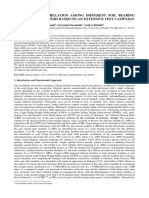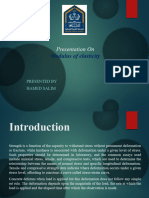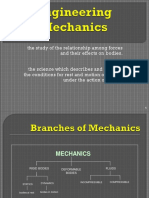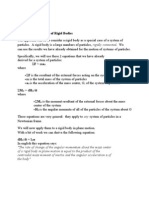Pavement Response Ullidtz& Zhang
Pavement Response Ullidtz& Zhang
Uploaded by
smouroCopyright:
Available Formats
Pavement Response Ullidtz& Zhang
Pavement Response Ullidtz& Zhang
Uploaded by
smouroOriginal Title
Copyright
Available Formats
Share this document
Did you find this document useful?
Is this content inappropriate?
Copyright:
Available Formats
Pavement Response Ullidtz& Zhang
Pavement Response Ullidtz& Zhang
Uploaded by
smouroCopyright:
Available Formats
Validation of Pavement Response and Performance Models
(Paper Number CS13-5)
Authors: Per Ullidtz
Technical University of Denmark Institute of Planning DTU. Building 115 2800 Lyngby Denmark E-mail: pullidtz@ivtb.dtu.dk Technical University of Denmark Institute of Planning DTU. Building 115 2800 Lyngby Denmark E-mail: wei@ivtb.dtu.dk Danish Road Institute Elisagaardsvej 5 P.O. Box 235 4000 Roskilde Denmark sub@vd.dk
Wei Zhang
Susanne Baltzer
Ullidtz, Zhang & Baltzer
ABSTRACT Mechanistic methods used for structural design and evaluation of pavements, make use of the theory of elasticity to calculate critical stresses and strains in the pavement layers. This method raises three questions: How can the elastic parameters of the materials, that are needed as input, be determined? How well does the theory predict the actual stresses and strains in the pavement structure? and How is pavement performance related to the pavement response?
This paper reports on the results from tests in the Danish Road Testing Machine and from an instrumented in situ test section (subgrade). The pavement was instrumented with gauges for measuring stresses or strains at critical positions. The first two questions above are strongly related. The following procedure has been used in an attempt at answering these questions. First, layer moduli were determined from FWD testing using different backcalculation procedures. Then, stresses and strains were calculated at the position of the instruments, and compared to the measured values. Procedures, where the subgrade was treated as a non-linear elastic material, were generally found to result in a reasonably good agreement between measured and calculated response. In two accelerated tests, relationships between the response in terms of resilient vertical strain or stress at the top of the subgrade and the performance in terms of the increase in plastic subgrade strain, or the change in overall roughness or rutting, have been studied. Relationships based on the internal energy density have been found to be the most promising.
1. INTRODUCTION Three different types of theoretical models may be used for the prediction of pavement response and performance: 1. Analytical models: The material parameters used with these type of models are the elastic parameters (Youngs modulus and Poissons ratio). Some models include cross-anisotropic materials and/or various interface conditions (from full friction to full slip), and other models may include visco-elastic characteristics (often in the form of a Burgers model). Most models are pure response models, and rely on empirical relations between the critical response and the rate of deterioration, sometimes using an incremental-recursive procedure for predicting the gradual deterioration in terms of fatigue cracking and permanent deformation. 2. Finite Element Methods (FEM): FEM may be used as an improved response model, where nonlinear stress-strain relationships, or dynamic loading, may be included. They may also be used to directly calculate permanent deformation based on viscous or plastic material parameters. FEM can also be used with fracture mechanics or continuum damage mechanics to predict a gradual structural deterioration (fatigue). 3. Distinct Element Methods (DEM): In DEM particles are treated individually, so that the input parameters are not in the form of constitutive equations, but consist of the size and shape of the particles, the degree of compaction, the particle stiffness and the coefficient of friction between the particles. With DEM there are no stresses or strains in the materials, but forces and
Ullidtz, Zhang & Baltzer
displacements of the particles. Response, permanent deformation and failure are treated in the same calculation process. The response part of the analytical methods and FEM are based on solid mechanics (continuum mechanics) and may be verified through a comparison of the predicted response to a measured response. 2. MEASUREMENT OF PAVEMENT RESPONSE The two main problems with respect to measuring pavement response are: the reliability of the measured values, and the durability of the measurement device. When a gauge is installed in a pavement material, it will influence the stress and strain conditions in the material. For a gauge and installation to be reliable, the output should be the response that would have occurred at the position of the gauge, if the gauge had not been present. Durability may be a problem both during installation of the gauge and during the experiments, if they extend over some period of time. 2.1 Displacements During the experiments described in this paper, deflections were only measured under FWD loading at the surface. These measurements are unintrusive and very accurate. During previous experiments, deflections within the pavement structure has been measured using geophones or accelerometers buried in the structure. To determine deflections, the signals from the geophones must be integrated once and those from the accelerometers twice. Under rolling wheel loading, with a high content of low frequencies, this may be a problem. An alternative is to use Multi Depth Deflectometer (MDD, de Beer et al. 1988) based on Linear Variable Differential Transformers (LVDT) or LVDTs anchored at different depths (Jansson & Wiman, 1994). In either case there may be problems with both accuracy and durability. 2.2 Strain in Asphalt The horizontal tensile strain at the bottom of the asphalt layer is an important design parameter. In 1982 the OECD initiated a Concerted Action on the Use of Large-Scale Research Facilities (OECD, 1985). As a part of this initiative, a number of different gauges for measuring strain in asphalt layers, were compared in a full-scale international experiment in Nardo in Southern Italy. Based on these experiments a new asphalt strain gauge was developed at the Technical University of Denmark (OECD, 1985b). This gauge contains a number of layers to protect against heat and mechanical impact during installation and against moisture during operation. This gauge normally has a 100% survival rate during installation, and some gauges are still functioning after more than seven years in an in-situ test section.
Ullidtz, Zhang & Baltzer
2.3 Stress in Soils and Unbound Materials A number of theoretical studies (Torry & Sparrow, 1966, Askegaard, 1979, Ullidtz & Busch, 1979) have shown that a pressure cell should have a high stiffness in relation to the media in which it is supposed to measure the stress (low flexibility), and that the ratio of thickness to diameter should be low (low aspect ratio). A cross section of the pressure cells, used in the experiments reported in this paper, is shown in Figure 1.
Figure 1. Cross section of pressure cell The liquid filled cavity above the gauge membrane ensures a very stiff cell. The cell has been calibrated in sand (Askegaard, 1996) and in clay (Zhang, Ebersohn & Selig, 1995) under highly varying stress conditions and load histories. The stress measured by the cell, q, was found to be (Ullidtz, Askegaard & Sjlin, 1996):
q = 110 1 0.01 ( 2 + 3 ) .
where 1, 2 and 3 are the major principal stresses. The cells are made of titanium and all cavities are filled with silicon rubber, to ensure a high durability. Six cells installed in the subgrade of three in situ test sections in Southern Sweden in 1991 were all functioning at the latest test in 1998. An in situ check on the gauge calibration can be obtained by integrating the stress bulb over the plane of the gauge, and comparing the result to the imposed load. 2.4 Strain in Soils and Unbound Materials Most strain measurements, both dynamic and static, were done using a gauge based on an LVDT. In one test the mu system from University of Nottingham was used in parallel. The agreement between the LVDT and mu strains was reasonably good, but due to a large noise to signal ratio with the mu gauges, the LVDTs were used in subsequent experiments.
Ullidtz, Zhang & Baltzer
Figure 2. LVDT based soil strain cell.
3. STRESSES IN SEMI-INFINITE HALF-SPACE Boussinesq's equations are developed for calculating stresses, strains and deflections in a homogenous, isotropic, linear elastic semi-infinite half-space. An evaluation of how well the theory predicts the actual stresses and strains in a structure should therefore be carried out in a media as close to the assumptions as possible. At a test in the Danish Road Testing Machine, the vertical normal stress under an FWD load was measured in a sand, with more than 90% of the grains falling within the sand fraction (60 m to 2 mm) (Ullidtz, Askegaard & Sjlin, 1996). The stress was measured with three different gauges. The sand was uniform to a depth of 700 mm and at a distance of 600 mm to either side of the gauges. All gauges were installed at a depth of 280 mm. An FWD with a 300 mm diameter loading plate was used to exert a known vertical force at the surface of the sand, with a contact stress of about 300 kPa (the exact stress was measured for each load). All the loads were imposed in the centerline of the gauges, but at different horizontal distances from the FWD to the gauges. The agreement between the three gauges was quite good, as seen in Figure 3.
Ullidtz, Zhang & Baltzer
250 Vertical Stress kPa 200 150 100 50 0 0 200 400 Distance mm Figure 3. Measured and theoretical vertical stress in half-space. Figure 3 also shows the theoretical stress at the depth of the gauges. At the centerline of the loading plate the theoretical stress is only about half of the measured stress. In calculating the theoretical stress, a parabolic stress distribution was assumed. For a rigid plate on an elastic medium, the theoretical stress at the edge of the plate should be infinitely large. On a granular material this is, of course, not possible. At the edge of the plate the bearing capacity is very small, resulting in stresses close to zero. Had the theoretical stress distribution for a rigid plate on an elastic medium been used, the difference between measured and calculated values would have been even larger. The same would be the case if a uniformly distributed load was assumed. One explanation of the difference could be that the measured stresses are too large. Integrating the stress bulbs over the plane of the gauges shows that the total force measured by the gauges is 1014% larger than the FWD peak load. This difference cannot explain the difference between measured and calculated values. Several factors that could have influenced the outcome of the measurements have been investigated: The sand material was not an infinite half-space but limited by a different material, both at the sides and at the bottom. Calculations with different assumptions for the modulus of the boundary material, indicated that this could not have influenced the measured values by more than a few percent. The load from the FWD is not static but dynamic. A simple uniaxial model of masses and springs was used to investigate this effect. It was found that the dynamic effects could cause the peak load at the plane of the gauges to be about 6% higher than the imposed load. This difference is in reasonably good agreement with the integration of the stress bulbs. The repeated loading with the FWD may have compacted the material in the line of the gauges to a higher modulus than the surrounding material. An FE-program showed that a 50% higher 600 800 Gauge 1 Gauge 2 Gauge 3 Bous
Ullidtz, Zhang & Baltzer
modulus in the column of material below the loading plate could increase the stress measured at the centerline by about 15%. Sand is not a linear elastic material. FEM calculations with the sand modulus being proportional to the bulk stress raised to a power of 0.5 and 1.0, showed that this non-linearity had only a minor effect on the stress distribution.
The conclusion is that the measured stresses are correct, and that the theory of elasticity cannot predict the stresses with a reasonable degree of accuracy. A good agreement with measured stresses can be obtained using Harrs probabilistic stress distribution (Harr, 1977) with a coefficient of lateral stress of 0.16, or by introducing a false depth of 180 mm, equal to 0.64 times the actual depth, in the theory of elasticity. 4. STRESSES AND STRAINS IN LAYERED STRUCTURES Stresses and strains have been measured in a number of pavements in the Danish Road Testing Machine (RTM) and in situ, both under FWD loading and under rolling wheels. When trying to verify response models the following procedure has often been followed: The stresses and strains are measured at different distances from an FWD with a hydraulic pad under the loading plate (to ensure a uniform load distribution) and/or under rolling wheel loads. Preferably the whole influence line is recorded, not just the peak values. Ordinary FWD tests are done on the pavement, and the deflection basin is recorded. The layer moduli are calculated using different theoretical response models, and different assumptions about the pavement (number of layers, non-linearities, rigid bottom etc.) Using these layer moduli, possibly adjusted for differences in temperature or loading time, the response is calculated at the position of the gauges, using the same response models employed in the backcalculation of layer moduli. Measured and calculated response is compared.
For a number of these verifications the program FeBack has been used. This program has three different response models: an axial symmetric Finite Element program (FE, Duncan et al. 1968, Ullidtz, 1998), a linear elastic analytical model for a layered system developed by F. van Cauwelaert for Waterways Experiment Station (WES) and the Method of Equivalent Thickness (MET) including a non-linear subgrade. An example of the input screen is shown in Figure 4.
Ullidtz, Zhang & Baltzer
Figure 4. Input screen for FeBack. In the example below, FeBack was used with the second test pavement from the International Pavement Subgrade Performance Study in the Danish Road Testing Machine (RTM) (Ertman Larsen & Ullidtz, 1997). The main aim of this study is to develop design criteria or deterioration models for subgrade materials, but a secondary aim is to verify existing response models. For this purpose the pavement is heavily instrumented, with eight asphalt strain gauges at the bottom of the asphalt, two vertical strain cells at the bottom of the base course, and strain cells and pressure cells for measuring the vertical, longitudinal and transverse strains and stresses in the top three layers (of approximately 150 mm each) of the subgrade. Some of these measurements are also used in the AMADEUS program (Advanced Models for Analytical Design of EUropean pavement Structures). A cross section of the pavement is shown in Figure 5.
Ullidtz, Zhang & Baltzer
Figure 5. Cross section of pavement in the RTM2 study. With MET and FEM the pavement was treated as a three-layer system (the filter gravel and concrete bottom was disregarded). With WES the modulus of the concrete bottom was fixed at 35000 MPa, and the modulus of the native soil below the concrete was allowed to vary. An example of layer moduli for a single test point, in MPa, is shown below. MET 6190 310 26 -0.6 WES 7550 74 104 35000 1710 FEM 6430 164 34 -0.54
E1 E2 E3 n E4 E5
All methods result in approximately the same asphalt modulus (E1, 25 C). The non-linear subgrade modulus (with MET and FEM) is expressed on the form: Em = E3 1 p where 1 is the major principal stress and p is a reference stress (here atmospheric pressure). Even though a rigid bottom is considered with the linear elastic approach (WES) the modulus of the base course (crushed gravel) is seen to be less than that of the subgrade (moraine clay). This is a
n
Ullidtz, Zhang & Baltzer
typical result with linear elastic methods. For the two methods where the subgrade is considered to be non-linear, the modulus of the base course layer is much more reasonable. The peak value of the horizontal strain at the bottom of the asphalt layer, the vertical stress at the top of the subgrade, and the vertical strain at the top of the subgrade are shown in the table below. The values were measured under FWD loading, and the average measured values are given, as well as the values calculated with the three response models, for the same load. Strains are in /m. MET WES FE Measured -273 -277 -279 -282 Horizontal strain in asphalt, Vertical stress on subgrade, kPa 73 132 70 90 1290 650 913 1390 Vertical strain in subgrade, All three methods are seen to predict the horizontal strain at the bottom of the asphalt layer reasonably well. This appears to be a general tendency. The vertical stress on the subgrade is overestimated by the linear elastic method, but underestimated for the two non-linear subgrades. The vertical strain in the subgrade, which is an important design parameter, is underestimated by a factor of two by the linear elastic method. The figure below shows the influence lines for vertical strain at the top of the subgrade, as measured by four different gauges and as predicted by the three different response models. In this case MET is seen to result in the best prediction. This has been found to be the case also in many other instances.
Vertical strain at top of subgrade
Distance from load centre, m -1 -0.5 0 0.5 MET WES FE 1 1800 1600 1400 1200 1000 800 600 400 200 0 -200
Figure 6. Measured and calculated vertical strain in subgrade. None of the methods could correctly predict the vertical strain at the bottom of the base course.
Ullidtz, Zhang & Baltzer
10
5. PAVEMENT PERFORMANCE Prediction of pavement performance from pavement response is the core of the analytical-empirical method of pavement design. Pavement performance may be composed by different measures of the functional condition (ride quality, safety) and structural condition (bearing capacity). This paper discusses models to estimate the plastic strain at the top of the subgrade and permanent deformation in the subgrade. Models for estimation of pavement deterioration are also studied. 5.1 Models for Estimation of Plastic Strains at the Top of the Subgrade A maximum permissible normal strain or stress at the top of the subgrade is used in pavement design based in the analytical-empirical method. Most of the empirical relations between load repetitions and permissible stress or strain being used today are of type: N a E permissible stress or strain = K * 6 * 10 E' where N E E' K, a and b
1 b
(5.1)
is the number of load repetitions to cause a certain deterioration, is the modulus of a material, is a reference modulus, and are constants or functions of the materials and environmental condition.
The permissible stress or strain in the equation above is normally obtained either from laboratory tests or from in-situ observation, and is based on the normal stress or strain (resilient value). For several test pavements built in the Danish Road Testing Machine, the resilient and plastic strains in the subgrade layers were recorded after different number of load repetitions with LVDTs. This makes it possible to establish a model for the development of plastic strain in the subgrade. Given a permissible permanent deformation of the subgrade, the corresponding number of load repetition may then be calculated. The assumption is made that the vertical plastic strain, pz, can be written as a function of the number of load repetitions, N; and of the resilient response in the following format: the strain model the stress model
pz = A * N * z pz
= A* N * z p
(5.2)
the energy density model pz
1 z = A* N * 2 p * z
where pz is the vertical plastic strain in microstrain at depth z,
Ullidtz, Zhang & Baltzer
11
z is the vertical resilient strain in microstrain at depth z, z is the vertical stress at depth z, p is a reference stress (here atmospheric pressure), and A, and are constants. The increment of the plastic strain at different load levels may be calculated using an incrementalrecursive procedure based on:
1
the strain mod el
d pz
A* z = * p pz
* dN
1
the stress mod el
d pz
A* z p = * p * dN pz A* 1 z 2 p z = * p * dN pz
1
the energy density mod el
d pz
Two test pavements for the International Pavement Subgrade Performance Study in the Danish Road Testing Machine (RTM) were constructed, instrumented and loaded. Based on the measured plastic strain in the subgrade layers of the first test pavement (RTM1), constants A, and for the strain-, stress-, and energy density model were computed using a minimization process in which the difference between the measured and estimated plastic strain were minimized. Then these constants were used to predict the plastic strain in the subgrade layers of the second test pavement (RTM2). The constants A, and for the strain-, stress-, and energy density model are given below. A 0.0121 158.81 0.453
Strain-model Stress-model Energy density -model
0.220 0.428 0.341
1.37 2.502 0.868
Figures 7 and 8 show the measured and estimated vertical plastic strain in the first subgrade layer of RTM1 and RTM2, respectively.
Ullidtz, Zhang & Baltzer
12
14000 12000 10000 Microstrain 8000 6000 4000 2000 0 0 10000 20000 30000 40000 50000 60000 Load repetition 70000 80000 90000 100000 Measured strain stress energy
Figure 7. Measured and estimated vertical plastic strain in the first subgrade layer of RTM1.
16000 14000 12000 Microstrain 10000 8000 6000 4000 2000 0 0 20000 40000 60000 80000 100000 120000 140000 Load repetition
Measured strain stress energy
Figure 8. Measured and estimated vertical plastic strain in the first subgrade layer of RTM2. The stress-, strain- and energy density models are also used to estimate the plastic strain in subgrade layers 2 and 3, and the estimated values are compared to the measured values. The result shows that the energy density model produces a reasonable estimation of plastic strain in the first subgrade layer for both RTM1 and RTM2. 5.2 Model for Estimation of Permanent Deformation in the Subgrade One of the objectives of the International Subgrade Performance study is to establish a subgrade rutting model. The permanent deformation in the subgrade is related to the plastic strain, so the energy density model is used to compute permanent deformation in the subgrade. Equation (5.2) can also have the following format, if the vertical resilient strain at depth z (z) is substituted by the ratio of the vertical stress (z) and the resilient modulus (E).
Ullidtz, Zhang & Baltzer
13
z2 *10 6( 1) pz = A * N * 2E p
(5.3)
where strains are in m/m (in equation (5.2) strains are given in m/m). The relationship between the plastic strain and plastic modulus can be expressed as follow:
E pz =
z pz z
substituti ng pz with equation(5.3) then gives E pz = z2 *10 6( 1) A* N 2E p (2C) ( n +12 ) = z 6( 1) ( 1) A* N * p *10 = C p * z p
where p Cp np
np
where E = C z p
(5.4) n p = n + 1 2
where
is a reference stress (atmospheric pressure), and is a material constant at a given number of load repetitions, is a material constant.
Equation (5.4) gives a relationship between the plastic modulus and vertical normal stress. The relationship between the permanent deformation (dpz) and vertical plastic strain (z) in the subgrade will have the following format: This formula is derived from Boussinesqs vertical displacement equation, when the constant modulus E is substituted by a non-linear function of the major principal stress.
d pz =
pz
(1 2 * n p )
*z
(5.5)
Ullidtz, Zhang & Baltzer
14
From equation (5.3) the plastic strain at different depth in the subgrade can be expressed in the following format:
pz1 p z2
2 z1 6 ( 1) A* N * 2 E p * 10 = 2 z2 6 ( 1) A* N * 2 E p * 10
= z pz1 = 2 z1
4
z2
z1
z = 2 z1
p z2
(5.6)
Using the preceding equations, a plastic strain at the top of the subgrade can be estimated when a permissible permanent deformation in the subgrade is given. Applying the energy density model (equation 5.2) and a computed resilient strain and stress at a certain load level, the permissible number of load repetitions can then be calculated. The two following cases are examples of this type of computation. Case 1: Input: permissible permanent deformation at the top of the subgrade is 10 mm; resilient strain is 8000 microstrain, (a 60 kN dual wheel load on RTM1); resilient stress is 160 kPa, (a 60 kN dual wheel load on RTM1); equivalent thickness to the subgrade 600 mm; elastic non-linearity parameter, n=-0.47 plastic non-linearity parameter, np=n+1-2=-0.47*0.868+1-2*0.868=-1.144; parameters in the model to estimate the plastic strains, A=0.453, =0.341 and =0.868 (the energy density-model); Output: the plastic strain at the top of the subgrade (using equation (5.5))
pz =
d pz (1 2 n p ) z
10 mm * (1 2 * ( 1.144 )) = 54800 strain 600 mm
Ullidtz, Zhang & Baltzer
15
the permissible number of load repetitions (using equation (5.2))
N =
pz
z 1 A* * z 2 '
pz N = z 1 A* * z 2 '
54800 = 0.868 0.453 1 * 8000* 0.16 0.1 2
1 0.341
= 164,729
To produce 10 mm rutting at the top of the subgrade in RTM1, a 60 kN wheel load with approximately 165,000 load repetitions is needed. This is a reasonable prediction considering the following facts for RTM1 after 100,000 load repetitions (a 20 kN wheel load with 50,000 load repetitions and 40 kN wheel load with 50,000 load repetitions): the permanent deformation at the top of the subgrade was approximately 4 mm; the resilient strain at the top of the subgrade was about 5300 microstrain. Case 2: Input: permissible permanent deformation at the top of the subgrade is 10 mm; resilient strain is 4500 microstrain, (a 60 kN dual wheel load on RTM2); resilient stress is 160 kPa, (a 60 kN dual wheel load on RTM2); equivalent thickness to the subgrade 570 mm; elastic non-linearity parameter, n=-0.57 plastic non-linearity parameter, np=n+1-2=-0.57*0.868+1-2*0.868=-1.231; parameters in the model to estimate the plastic strain, A=0.453, =0.341 and =0.868 (the energy density-model); Output: the plastic strain at the top of the subgrade (using equation (5.5))
pz =
d pz (1 2n p ) z
10 mm * (1 2 * ( 1.231)) = 60737 strain 570 mm
Ullidtz, Zhang & Baltzer
16
the permissible number of load repetitions (using equation (5.2))
N =
pz
z 1 A* * z 2 '
pz N = z 1 A* * z 2 '
0.341 60737 = = 963442 , 0.868 0.453 1 * 4500* 0.16 0.1 2
To produce 10 mm rutting at the top of the subgrade in RTM2, a 60 kN wheel load with approximately 960,000 load repetitions is needed. This is a reasonable prediction based on the following facts for RTM2 after 150,000 load repetitions (a 40, 50 and 60 kN dual wheel load with 50,000 load repetitions each): the permanent deformation at the top of the subgrade was approximately 3 mm; the resilient strain at the top of the subgrade was about 4500 microstrain. Table 1 summarizes the measured and estimated values of RTM1 and RTM2 used in the estimation for the number of load repetitions, which will produce a permanent deformation of 10 mm at the top of the subgrade.
Table 1 The measured and estimated values of RTM1 and RTM2 used in the estimation for load repetitions
Dual wheel load (kN) Load repetitions (thousand) Total load repetitions Measured vertical resilient strain in SGL1 () Plastic strains at the top of the subgrade () Permanent deformation at the top of subgrade (mm) Vertical resilient strain used in the estimation () Vertical stress used in the estimation (kPa) Load repetitions to produce 10 mm permanent deformation at the top of the subgrade, at 60 kN 1 measured under the 40 kN dual wheel after 100,000 load repetitions. 2 measured under the 60 kN dual wheel after 150,000 load repetitions. 3 computed from the measured strain in the first subgrade layer under a 60 kN dual wheel.
RTM1 20 40 50 50 100,000 40001 19640 3.82 80003 160 165,000
RTM2 40 50 60 50 50 50 150,000 28002 17343 2.86 45003 160 960,000
Ullidtz, Zhang & Baltzer
17
The number of load repetitions to produce 10 mm permanent deformation at the top of the subgrade for RTM1 is much less than for RTM2. The large difference in the number of load repetitions is mainly due to the vertical resilient strains in the subgrade. Relatively large vertical resilient strains in subgrade layer 1 of RTM1 were recorded. The vertical resilient strain at the top of the subgrade used in the estimation is 8000 microstrain for RTM1 and 4500 microstrain for RTM2. The deterioration rate of RTM1 is much higher than that of RTM2. 5.3 Models for Predicting Roughness and Rut Depth of Pavements Longitudinal and transverse surface profiles of RTM1 and RTM2 were observed at different number of load repetitions. Roughness measured with Slope Variance (SV) and International Roughness Index (IRI) was obtained from the measured longitudinal profiles, and Rut Depth (RD) was computed from the measured transverse profiles. A model to predict SV, IRI and RD was established based on the measured vertical resilient strain and stress in the subgrade. The assumption made in the models was that SV, IRI and RD are functions of the number of applied load repetitions and of the internal energy density. The model has the following format:
1 z SV ( IRI or RD) = A * N * z 2 p
the energy density model
The increment of SV (IRI or RD) at different load levels may then be calculated using an incremental-recursive procedure based on:
A* 1 z 2 z p d ( SV ) = * SV * SV
* dN
the energy density mod el
where SV may be substituted by IRI or RD, z is the vertical resilient strain at the top of the subgrade, z is the vertical stress at the top of the subgrade, p is a reference stress (atmospheric pressure, 0.1 MPa), and A, and are parameters derived from the experimental data. Using this procedure, parameters A, and for SV, IRI and RD are obtained based on the experimental data collected on RTM1, and listed in the following table.
Ullidtz, Zhang & Baltzer
18
Parameters A, and for SV, IRI and RD. A SV 1.92*10-4 Energy-model IRI 5.92*10-5 RD 3.03*10-4
0.341 0.341 0.341
0.868 0.868 0.868
Figure 9 to 11 shows the measured and predicted SV, IRI and RD of RTM1, respectively, while figure 12 to 14 shows the measured and predicted SV, IRI and RD of RTM2, respectively.
8 7 Measured 6 predicted 5 SV 4 3 2 1 0 0 10000 20000 30000 40000 50000 60000 70000 80000 90000 100000 Load repetition
Figure 9 Measured and predicted SV for RTM1
2.5 Measured predicted IRI m/km 1.5
2.0
1.0
0.5
0.0 0 10000 20000 30000 40000 50000 60000 70000 80000 90000 100000 Load repetition
Figure 10 Measured and predicted IRI for RTM1
Ullidtz, Zhang & Baltzer
19
12 10 Rut depth mm 8 6 4 2 0 0 10000 20000 30000 40000 50000 60000 70000 80000 90000 100000 Load repetition Measured predicted
Figure 11 Measured and predicted RD for RTM1
10 Measured 8 predicted 6 SV 4 2 0 0 20000 40000 60000 80000 Load repetitions 100000 120000 140000
Figure 12 Measured and predicted SV for RTM2
5 Measured predicted IRI m/km 3
0 0 20000 40000 60000 80000 Load repetitions 100000 120000 140000
Figure 13 Measured and predicted IRI for RTM2
Ullidtz, Zhang & Baltzer
20
20 18 16 Rut depth mm 14 12 10 8 6 4 2 0 0 20000 40000 60000 80000 Load repetitions 100000 120000 140000 Measured predicted
Figure 14 Measured and predicted RD for RTM2 With the energy density model the predicted SV, IRI and RD fit the measured values reasonably well. 6. CONCLUSION Currently used models for calculating pavement response are based on a number of simplifications. Although some of the more advanced Finite Element models may include dynamic loading, viscous and plastic materials characteristics and the dependency of material characteristics on stress or strain conditions, they are still based on continuum mechanics, whereas most pavement materials have discontinuities and many even are particulate. The validity of these models must, therefore, be experimentally verified. Experiments, where theoretical stresses and strains have been compared to measured values, show some of the limits of the existing methods. But there are also indications that some of the important design parameters (horizontal strain at the bottom of an asphalt layer, vertical strain at the top of the subgrade) can be predicted with a reasonable degree of accuracy, even when using highly simplified methods like the Method of Equivalent Thicknesses (MET). There appears to be a need for developments on two fronts: One is the development of more realistic models, with a reduced discrepancy between the nature of real pavement materials and the assumptions on which the models are based. These sophisticated models are needed to get a better understanding of the behavior of pavement materials and pavement structures. The other need is for models that may be used for every day evaluation of pavement structures. These simplified models are needed for the practical work of highway engineers. On both fronts, however, it is of paramount importance that the models be verified against the reality of actual pavement materials and actual road structures. REFERENCES Askegaard, V. Pressure Cell Calibration Tests, Report No 9508, Series S, Department of Structural Engineering and Materials, The Technical University of Denmark, 1996
Ullidtz, Zhang & Baltzer
21
Askegaard, V. Stress and strain measurements in solid materials, Report No. R 92, Dept. of Structural Engineering, Technical University of Denmark, 1979. de Beer, M, Horak, E. & Visser, A.T. The Multi-depth Deflectometer (MDD) system for determining the effective elastic moduli of pavement layers, First International Symposium on nondestructive testing of pavements and backcalculation of moduli, Baltimore, June 1988. Duncan, J.M., Monismith, C.L. & Wilson, E.L. Finite Element Analysis of Pavements, Highway Research Record 228, 1968. Ertman Larsen, H.J. & Ullidtz, P. Pavement Subgrade Performance Study in the Danish Road Testing Machine, Eighth International Conference on Asphalt Pavements, Proceedings Vol. 1, University of Washington, Seattle 1997. Harr, M.T. Mechanics of Particulate Media, McGraw-Hill, New York, 1977. Jansson, H. & Wiman, L.G. Mtta och berknade deformationer i vgen vid fallviktsmtning (Pavement analysis based on measured in-depth deflection data"), VTI meddelande Nr 738, 1994 (in Swedish, summary in English). OECD Full-scale Pavement Tests, Road Transport Research, Organisation for Economic Cooperation and Development, Paris, 1985a. OECD Strain Measurements in Bituminous Layers, Organisation for Economic Co-operation and Development, Paris, 1985b. Tory, C. & Sparrow, R.W. Behaviour of a Soil Mass under Dynamic Loading, Journal of the Soil Mechanics and Foundation Division, Proceedings of the American Society of Civil Engineers, 1966. Ullidtz, P. & Busch, C. Laboratory Testing of a Full Scale Pavement: The Danish Road Testing Machine, Transportation Research Record 715, Transportation Research Board, 1979. Ullidtz, P., Askegaard, V. & Sjlin, F.O. Normal Stresses in a Granular Material Under Falling Weight Deflectometer Loading, Transportation Research Record 1540, Transportation Research Board, 1996. Ullidtz, P. Modelling Flexible Pavement Response and Performance, Polyteknisk Forlag, Lyngby 1998. Zhang, J., Ebersohn, W & Selig, E.T. Evaluation of Earth Pressure Cells For Pavement Subgrade Performance Study, Geotechnical Report No. CRR95-427F, University of Massachusetts, 1995.
You might also like
- Flexural or Bending Test Lab ReportDocument9 pagesFlexural or Bending Test Lab ReportKalKatu MaLam73% (22)
- Experiment 2 - COMPRESSION TEST OF TIMBER SPECIMENDocument9 pagesExperiment 2 - COMPRESSION TEST OF TIMBER SPECIMENSamiha Maysoon Nooria67% (3)
- Calculation Sheet For Friction Collar PDFDocument18 pagesCalculation Sheet For Friction Collar PDFMohamed AdelNo ratings yet
- Compression Lab ReportDocument15 pagesCompression Lab ReportThomas Owens43% (14)
- Lab Tensile UTHMDocument27 pagesLab Tensile UTHMMuhd Farhan Bin Ibrahim100% (1)
- Chapter 14 - Vapor-Compression-System Analysis: C C AmbDocument11 pagesChapter 14 - Vapor-Compression-System Analysis: C C AmbaafgaloNo ratings yet
- ResilienceDocument16 pagesResiliencem abdullah m akmalNo ratings yet
- Nelsen Zornberg 2020Document10 pagesNelsen Zornberg 2020SophiaNo ratings yet
- Laboratory_fatigue_assessment_of_large_geocompositDocument10 pagesLaboratory_fatigue_assessment_of_large_geocomposithvthang1981No ratings yet
- 249-Failure Load Prediction of A Tubular Bonded Structures Using A CoupledDocument11 pages249-Failure Load Prediction of A Tubular Bonded Structures Using A CoupledjinshuaixuNo ratings yet
- Design and Construct A Horizontal Tensile Testing Machine For Polymer CompositesDocument49 pagesDesign and Construct A Horizontal Tensile Testing Machine For Polymer CompositeschinweubaonovoNo ratings yet
- ArchimerDocument16 pagesArchimerHamed MasterNo ratings yet
- Study of A Uniaxial Tension Test MethodologyDocument28 pagesStudy of A Uniaxial Tension Test MethodologyJuan Diego Vargas MendozaNo ratings yet
- Porosity Expansion of Tablets As A Result of Bonding and Deformation of Particulate SolidsDocument9 pagesPorosity Expansion of Tablets As A Result of Bonding and Deformation of Particulate SolidsCesar Rodolfo Angulo DelgadoNo ratings yet
- Modelling Resilient Modulus of JKR's Crushed Rock Base MaterialDocument8 pagesModelling Resilient Modulus of JKR's Crushed Rock Base Materialpave_manNo ratings yet
- Tension LabDocument4 pagesTension LabWilliamMermell100% (1)
- Altinbas University Industrial Engineering Ie258 Manufacturing Process Lab. Tension, Bending, Compression and Torsion TestDocument19 pagesAltinbas University Industrial Engineering Ie258 Manufacturing Process Lab. Tension, Bending, Compression and Torsion TestHusam JARRAR100% (1)
- Axial - Loaded Pile PLAXIS 2dDocument4 pagesAxial - Loaded Pile PLAXIS 2dMarko AdamovićNo ratings yet
- Flexible Adhesives Workshop Handout 12june01Document4 pagesFlexible Adhesives Workshop Handout 12june01vilukNo ratings yet
- Lichauco Activity5ansysDocument14 pagesLichauco Activity5ansysNATHANIEL YACASNo ratings yet
- Introduction To Triaxial Testing - Part 2Document5 pagesIntroduction To Triaxial Testing - Part 2Peteris Skels100% (1)
- Burst & Gross Plastic Deformation Limit StateDocument8 pagesBurst & Gross Plastic Deformation Limit StateMichelle GrossNo ratings yet
- 1.ogundipe JournalDocument8 pages1.ogundipe JournalEmily PattonNo ratings yet
- M.Sc. in Civil Engineering Department of Civil Engineering Military Institute of Science & Technology (MIST) CE 6505 Structural Design of PavementsDocument53 pagesM.Sc. in Civil Engineering Department of Civil Engineering Military Institute of Science & Technology (MIST) CE 6505 Structural Design of PavementsAyesha AkhterNo ratings yet
- Analysis of Wear Using LS - DYNADocument10 pagesAnalysis of Wear Using LS - DYNAwondwosenAyeleNo ratings yet
- Tensile TestDocument9 pagesTensile Testonkod1No ratings yet
- Stress-Strain Curve 3. Short Term Mechanical PropertiesDocument183 pagesStress-Strain Curve 3. Short Term Mechanical PropertieskhagendrakryadavNo ratings yet
- Validation of Simple Shear Tests For Parameter Identification Considering The Evolution of Plastic AnisotropyDocument9 pagesValidation of Simple Shear Tests For Parameter Identification Considering The Evolution of Plastic AnisotropyPedro Troncoso AcuñaNo ratings yet
- Tension TestDocument7 pagesTension TestmanmathkNo ratings yet
- Damage Initiation Mechanism in Rubber Sheet Composites During The Static LoadingDocument8 pagesDamage Initiation Mechanism in Rubber Sheet Composites During The Static LoadingMa RcoNo ratings yet
- JCTR Bonded Joints PaperDocument32 pagesJCTR Bonded Joints PaperAntonio CarusoNo ratings yet
- Tensile TestingDocument4 pagesTensile TestingNaveed AfzalNo ratings yet
- Diametral Compression TestDocument11 pagesDiametral Compression TestCesar Rodolfo Angulo DelgadoNo ratings yet
- Nadot 2006Document22 pagesNadot 2006Majed NesrineNo ratings yet
- Tensile Testing by Odewole TemidayoDocument10 pagesTensile Testing by Odewole Temidayostephenoladipo21No ratings yet
- Gonzalez Et Al 2007 Evaluating Nonlinear Elastic Models For Unbound Granular Materials in Accelerated Testing FacilityDocument9 pagesGonzalez Et Al 2007 Evaluating Nonlinear Elastic Models For Unbound Granular Materials in Accelerated Testing Facilitysidhyanath pandaNo ratings yet
- Hypervelocity Impact Damage in Composites PDFDocument24 pagesHypervelocity Impact Damage in Composites PDFbedo39No ratings yet
- Epoxy Rubber MountDocument14 pagesEpoxy Rubber MountMIC MECHNo ratings yet
- An Assessment of Safety Factor For Tunnels Excavated in Soils and Jointed Rock MassDocument8 pagesAn Assessment of Safety Factor For Tunnels Excavated in Soils and Jointed Rock MassHarold TaylorNo ratings yet
- J Engfracmech 2013 05 014Document12 pagesJ Engfracmech 2013 05 014Ali ANo ratings yet
- Table of Content Content 1.0 Project Background 2Document17 pagesTable of Content Content 1.0 Project Background 2Muhammad SyahmieNo ratings yet
- Tensile Testing Asm StandardDocument13 pagesTensile Testing Asm StandardNinad PawarNo ratings yet
- S B P G S S R L A S: Technical Paper by A. Mcgown, I. Yogarajah, K.Z. Andrawes and M.A. SaadDocument15 pagesS B P G S S R L A S: Technical Paper by A. Mcgown, I. Yogarajah, K.Z. Andrawes and M.A. SaadRaluca IoanaNo ratings yet
- 2 Resilient Modulus BuchananDocument0 pages2 Resilient Modulus BuchananJuanDiegoRojasNo ratings yet
- Finite Element Analysis and Reliability Assessment of Spherical LPG ...Document6 pagesFinite Element Analysis and Reliability Assessment of Spherical LPG ...Suleyman HaliciogluNo ratings yet
- Geotextile GeomembraneDocument27 pagesGeotextile GeomembraneSyazwi SyafiqNo ratings yet
- Pile Group Settlement Analysis On The Basis of Static Load TestDocument9 pagesPile Group Settlement Analysis On The Basis of Static Load TestKam PaolinoNo ratings yet
- (2083831X - Studia Geotechnica Et Mechanica) Static Load Test On Instrumented Pile - Field Data and Numerical SimulationsDocument9 pages(2083831X - Studia Geotechnica Et Mechanica) Static Load Test On Instrumented Pile - Field Data and Numerical SimulationsMahindaNo ratings yet
- Numerical Study of The Thickness TransitDocument8 pagesNumerical Study of The Thickness Transitkalel.sv88No ratings yet
- Proposal of Correlation Among Different Soil Bearing Capacity Parameters Based On An Extensive Test CampaignDocument7 pagesProposal of Correlation Among Different Soil Bearing Capacity Parameters Based On An Extensive Test CampaignCarlos CabanasNo ratings yet
- Elasticity Stress-Strain Curve2222Document20 pagesElasticity Stress-Strain Curve2222mohammad hafody100% (1)
- Load Transfer of Polycarbonate Blast Resistant Glazing SystemsDocument10 pagesLoad Transfer of Polycarbonate Blast Resistant Glazing SystemsDiego Zenteno CornejoNo ratings yet
- Fatigue AnalysisDocument23 pagesFatigue AnalysisarnoldmarshalNo ratings yet
- DEM Validation Using An Annular Shear CellDocument12 pagesDEM Validation Using An Annular Shear Cellabdoulay.fallNo ratings yet
- Triaxial Paper Alsaleh ShbeebDocument38 pagesTriaxial Paper Alsaleh Shbeebvcox4460No ratings yet
- Impact Strenght of ConcreteDocument7 pagesImpact Strenght of ConcreteSalko ĆosićNo ratings yet
- The Mechanical Properties of Wood: Including a Discussion of the Factors Affecting the Mechanical Properties, and Methods of Timber TestingFrom EverandThe Mechanical Properties of Wood: Including a Discussion of the Factors Affecting the Mechanical Properties, and Methods of Timber TestingNo ratings yet
- Spectral method for fatigue damage estimation with non-zero mean stressFrom EverandSpectral method for fatigue damage estimation with non-zero mean stressNo ratings yet
- Transfer of Solids: 5.1. Slurry TransportDocument8 pagesTransfer of Solids: 5.1. Slurry TransportKevin Alberto Tejera PereiraNo ratings yet
- Statics of Rigid BodiesDocument57 pagesStatics of Rigid BodiesAnna Louise Wy100% (1)
- Esquema Electrio Cargador LE TORNEAU 1850 PDFDocument6 pagesEsquema Electrio Cargador LE TORNEAU 1850 PDFDaniel Alejandro Iturbe PintoNo ratings yet
- 767 - 49 ApuDocument22 pages767 - 49 ApuAndres Aldunate QuezadaNo ratings yet
- Cash Flow Projection PT SMKDocument1 pageCash Flow Projection PT SMKPricx GamingNo ratings yet
- Instrument Engineer Test 1 PDFDocument22 pagesInstrument Engineer Test 1 PDFariffabusemanNo ratings yet
- Custom Built Test RigsDocument4 pagesCustom Built Test Rigssatchit sidhayeNo ratings yet
- (03-07) - Fuel Injection Nozzle - 4-390 4T-390 EmissionsDocument3 pages(03-07) - Fuel Injection Nozzle - 4-390 4T-390 EmissionseduardoNo ratings yet
- Thermo 2, Lecture1 PDFDocument99 pagesThermo 2, Lecture1 PDFMaricar HababagNo ratings yet
- Engine Cooling - TD4 2.2L Diesel - Cooling System Draining Filling and BleedingDocument3 pagesEngine Cooling - TD4 2.2L Diesel - Cooling System Draining Filling and BleedingNhật Anh TrầnNo ratings yet
- Ce580 OutlineDocument2 pagesCe580 OutlineDeniz C. AydinNo ratings yet
- Co2 System Cylinder Valve AssemblyDocument2 pagesCo2 System Cylinder Valve AssemblyFahmiNo ratings yet
- Project: Mall at Bommasandra, Bangalore Heat Load SummaryDocument3 pagesProject: Mall at Bommasandra, Bangalore Heat Load SummaryAnonymous MDkp0hnb3lNo ratings yet
- Technical Note: I - Subject: Diagnostics of The Power Steering Hydraulic CircuitDocument2 pagesTechnical Note: I - Subject: Diagnostics of The Power Steering Hydraulic Circuitmebarki aberraoufNo ratings yet
- Ceramic Matrix Composites in The Design and Development of Convergent-Divergent Nozzle ComponentsDocument10 pagesCeramic Matrix Composites in The Design and Development of Convergent-Divergent Nozzle ComponentsRajeshKumarSahuNo ratings yet
- Central Blower Laboratory Fan CatalogDocument16 pagesCentral Blower Laboratory Fan Catalogrogel_ganaNo ratings yet
- Materials 14 00567Document15 pagesMaterials 14 00567Amela ShahiniNo ratings yet
- Pekerjaan Instalasi SprinklerDocument2 pagesPekerjaan Instalasi SprinklerM. Bawono Shidiq - Jakarta UtaraNo ratings yet
- Whitepaper Structural Bolting and Use of Fasteners 1Document32 pagesWhitepaper Structural Bolting and Use of Fasteners 1sklNo ratings yet
- FogBuster InstallDocument5 pagesFogBuster Installth.wilbersNo ratings yet
- CSP0000535-01.FLSmidth Current Bill of MaterialDocument178 pagesCSP0000535-01.FLSmidth Current Bill of MaterialJames Oliver Jove HurtadoNo ratings yet
- Failure Theory in MetalsDocument16 pagesFailure Theory in MetalsManoj SainiNo ratings yet
- E1A - Flame StabilityDocument9 pagesE1A - Flame StabilityMuhammadAsyrafNo ratings yet
- Vigas Casteladas PDFDocument5 pagesVigas Casteladas PDFroloheNo ratings yet
- Pneumatic TDF Folding MachineDocument4 pagesPneumatic TDF Folding MachineIBRAHIM AL-SURAIHINo ratings yet
- General Plane Motion of Rigid BodiesDocument9 pagesGeneral Plane Motion of Rigid BodiesArvin NaborNo ratings yet
- 05729c454 PDFDocument6 pages05729c454 PDFManu ChakkingalNo ratings yet
- Ttgn5 4 Bostraben App4Document8 pagesTtgn5 4 Bostraben App4javierNo ratings yet

